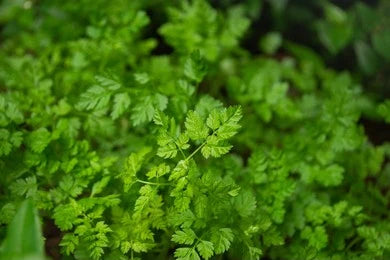According to estimates from the World Health Organization (WHO), 80% of people worldwide use herbs to cure a variety of diseases. Herbs are regarded as the natural remedy that is frequently employed in the conventional medical system. All throughout the world, people are getting more and more interested in herbs. The WHO estimates that 21,000 plant species have the potential to be used as medicinal plants.
Chervil is one such plant that has the potential to be employed globally in cutting-edge pharmaceuticals. Chervil is a member of the carrot family, and the leaves are quite similar to the tops of carrots. This plant was viewed as a representation of revitalization in the past. This plant is safe to eat in huge numbers and doesn't cause any health risks. It is really nourishing. The roots and leaves are more frequently utilized, however, the entire herb can be eaten. It has a wide range of pharmacological properties and is a good source of vitamins and minerals.
There are four primary types of chervil. Garden Chervil, Wild Chervil, Root Chervil, and Bur Chervil are the different types. The most widely utilized of these kinds is garden chervil.
Chervil, also referred to as Gourmet's Parsley, is a very delicate herb that is also quite nutritious. There are 12 different species of this plant, some of which are poisonous.
Geographical Distribution
Chervil originated in the Caspian Sea region but was introduced to most of the European continent by the Romans from temperate regions of Asia. Chervil is the most common cultivar in the United Kingdom, Germany, and the United States. Chervil is not grown in India.
- Botanical Name: Anthriscus Cerefolium
- Common Name: Chervil, French Herb, Rich Man’s Parsley
- Family: Apiaceae (Umbelliferae)
- Edible Part: Leaves and Root
Morphological Characteristics
An annual plant that grows 12-24 inches in height. The leaves are lacy and fern-like and light green in color. The leaves are divided again into opposite and deep-cut leaflets. The flowers are white in color, dainty, and delicately arranged in small umbels. The fruit is long, segmented, and berry-like.
Pharmacological Importance
- Expectorant: It facilitates the release of mucus into the airways.
- Digestive: Since it's made up of fiber, it helps with digestion.
- Anti-oxidant: It works as an antioxidant because it fights against free radicals, which helps boost your immunity.
- Anti-inflammatory: Its anti-inflammatory properties make it an effective herb for colds and flu.
This herb has leaves that can help with digestion, so it's used to infuse fresh leaves to help with digestive issues.
Health Benefits
Skin Disorders:- This herb is great for treating skin issues like acne, eczema, and hemorrhoids. It's anti-inflammatory, so it can help reduce redness, itchiness, and inflammation. Plus, it's a great ingredient for creams that help treat hemorrhoids and scarring.
Blood Disorders:- This herb is used to normalize high blood pressure because of its blood-thinning and anti-hypertensive effects.
- It also protects against anemia because it is a strong source of zinc and iron.
- Additionally, chervil is effective in treating varicose veins and is believed to improve blood circulation.
- it is also helpful in the management of low blood pressure.
Cardiovascular Health:- Cardiovascular diseases can result from impaired nitric oxide (NO) availability in the vascular system, which can be avoided by consuming enough nitrate and nitrite molecules. Green leafy vegetables are the best sources of nitrate and nitrite in the diet, while chervil is one of the top providers of nitric oxide.
Cough and Bronchitis:- The herb chervil is well-known for its ability to clear the respiratory tract of excess mucus thanks to its expectorant properties.
Diuretic in Nature:- Because the chervil herb has a diuretic effect, it aids in elimination by encouraging urine, which facilitates the removal of toxins and waste products from the body. Additionally, it helps in the treatment of kidney and bladder stones as well as cystitis.
Acts as a Detoxifying Agent:- Being a detoxifying agent, it lessens the appearance of wrinkles, dark spots, fine lines, and other early indicators of aging. Additionally, this plant cleans the blood, which helps the skin appear smoother and younger.
Other Uses
- The herb chervil helps with gum disease and both prevents and treats oral ulcers.
- Chew some fresh chervil leaves to halt hiccups.
- Both those who suffer from depression and the functioning of the human brain can benefit from this plant.
- Due to its ability to reduce pain and swelling, it is also utilized in the creation of herbal eyewash. Additionally, it has a lot of vitamin A, which helps to improve eye eyesight.
- This herb relaxes the internal organs by toning the epithelial lining, acting as a tonic for the body.
- The juice from its stem and leaves is applied to blemishes, and an infusion of fresh leaves is used as a skin lotion and cleanser.
- Menstrual cramps can be effectively treated with chervil plant extract.
Flavoring Agent
This plant's leaves and stems can be used in cooking.
- Additionally used as a flavor, this herb. Drying the plant or overheating it can quickly degrade its flavor. Thus, it should be used in its unprocessed state.
- Its leaves are used for garnishing since they make a beautiful herb.

